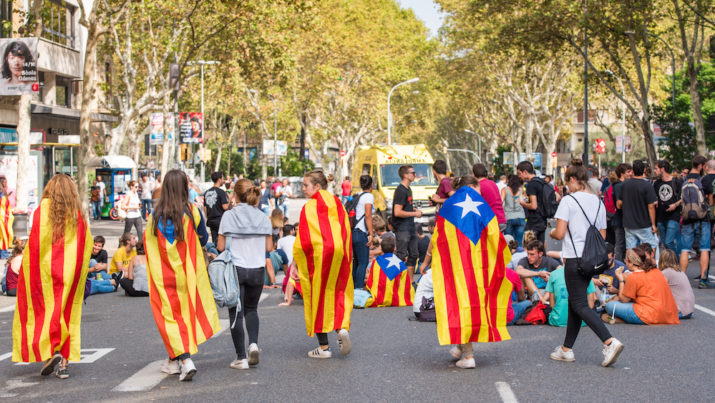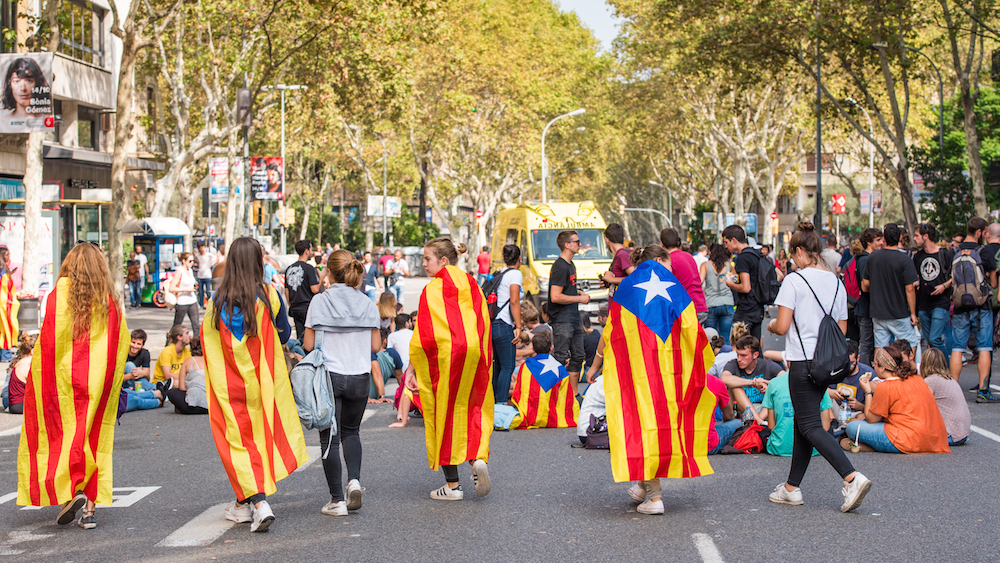
Delegitimizing Authority: The First of October and the History of Police Violence in Catalonia

On October 1, 2017, the Catalan government held a referendum on independence despite the fact that the Spanish Constitutional Court had ruled such a vote unconstitutional.[1] The Spanish government made efforts to prevent the vote from taking place, but on the first, over 2 million people voted at some 2,000 polling stations.[2] The central government sent in 4,500-6,000 civil guards and national police, who forcibly closed ninety-two polling places by charging at voters and demonstrators with riot gear and batons to disperse the crowds.[3] Catalan authorities claimed that over 800 civilians were hurt, while the Spanish government maintained that 431 of its own forces suffered injuries.[4] The vast majority of these injuries were minor, but what mattered is that images and videos of police in riot gear beating protesters and passive demonstrators dominated the coverage of the referendum in international media and social media, with some international leaders and human rights organizations denouncing the violence while 15,000 people protested in Barcelona on October 3.[5]
The reasoning behind the central government’s decision to deploy the police on October 1st to shut down polling places remains unclear, given that only a small percentage of the stations were targeted. Was the goal to delegitimize the vote further by reducing turnout, to intimate others from voting, or simply to show that something was being done to stop a vote that had been ruled unconstitutional? A full understanding of the structural causes of the violence on October 1, 2017 (or the 1-O, as the events of the day have become known) will require the dedicated efforts of future historians who have the resources and temporal distance that allow for extensive interviews to be conducted and archival documents to be consulted. The aim here is to suggest one area where those long-term causes may be found, namely, in the history of the modern Spanish state’s approach to public order. While Catalan separatists will draw parallels with Spain’s dictatorships, I find that looking to Spain’s previous liberal regimes a closer and more instructive comparison. Drawing on the work of historians like Manuel Ballbé and Eduardo González Calleja, I argue that because of the continued need for constitutional regimes in Spain to establish legitimacy, they have long deployed the police to quell potential threats to the authority of the state, and in so doing, have further undermined the legitimacy of the regime in the eyes of the citizenry.[6] Which is not to say that these liberal states are authoritarian, they lack the political structures of a dictatorship, but insofar as they use violence as a tool for keeping opposition movements demobilized, the line between liberalism and authoritarianism is blurred. I highlight examples of this pattern of police deployments to be found in the city of Barcelona during the Restoration and Second Republic periods in particular, and then suggest that last year’s incident represents a similar undermining of legitimacy through an assertion of authority.
After a period of extreme political instability from 1868-1874, the Restoration (1874-1923) further entrenched a preexisting pattern of liberal states in Spain, relying on the forces of public order to compensate for their legitimacy deficits. The Restoration sought to restore order and remove the need for military intervention in Spanish politics by a system of political parties alternating power through rigged elections. This system of electoral manipulation relied on political demobilization to function. The Civil Guard, Spain’s national militarized police force, became one of the primary tools through which the Restoration regime maintained this demobilization; guards were regularly ordered to stamp out protests and sometimes to manipulate elections. Since rigged elections could not serve as a source of legitimacy and a way for citizens to express their frustrations with the regime, especially after defeat in the Spanish-American War of 1898, increasing numbers of people turned to political movements that sought to challenge the Restoration system entirely. These movements included republicanism, anarchism, and Catalan nationalism. Restoration governments responded by continuing the habit of asserting their authority with armed force that they had inherited from mid-nineteenth century liberalism. They made the Civil Guard part of the army and declared martial law frequently while the courts established precedents that gave members of the armed forces virtual impunity under the law.[7] In the 1890s, the Civil Guard and police engaged in a back-and-forth with anarchists, with anarchists planting bombs and police responding with mass arrests and torture in order to obtain judicial orders to carry out executions.
The case of Barcelona, which had become a hot-bed of anarchist activity because of the social changes that accompanied its industrialization, demonstrates how the Restoration’s hardline policies on public order could backfire. After six were killed in a bombing there in 1896, the central government took the heavy-handed approach of passing a new anti-terrorism bill that outlawed the anarchist movement altogether, while the captain general of Barcelona declared a state of emergency that gave Civil Guard Lieutenant Narciso Portas Ascanio and his team free rein to carry out a crackdown.[8] Portas used his emergency powers to arrest 300 people of any and all radical left-wing persuasions.[9] Then, his team interrogated the suspects in the Montjuïc prison, using torture to build a case again five anarchists who frequented a working-class bar. Despite numerous accusations that Portas’ team had tortured the suspects, the five were found guilty and executed, and sixty-three more were sent to a penal colony in Morocco.[10] Portas had brought results, but at a cost. Many writers were jailed in Montjuïc, and they managed to smuggle out horrific accounts of the tortures there. The news provoked an international outcry, and both anarchists and republicans learned that denouncing such cases in the press was an effective way to undermine public support for the Restoration regime.
The violence only increased in the first decade of the twentieth century as greater numbers of police had to be called in to counter better-organized resistance movements. Opposition groups began to form more formal political organizations— the Catalanists’ Lliga Party was founded in 1901, the Republicans’ Radical Party in 1908 and the anarchist union known as the CNT (Confederación Nacional del Trabajo) in 1910. Urban strikes involved larger, more coordinated efforts, yet the large concentrations of civil guards sent to counter them were untrained in controlling hostile crowds. Indicative of this new trend was Barcelona’s first general strike in 1902, the harsh suppression of which was avenged by the 1905 bombing of the city’s flower market.[11] The violence reached a peak in what is known as the Tragic Week of 1909, when over one hundred people were killed in street fighting in Barcelona. Almost all of the dead were killed by urban workers the Civil Guard and the army. Once again, there was international outcry over the mass arrests and executions that followed the unrest, this time to the point of precipitating the fall of the Conservative government of Antonio Maura.[12] Between 1917 and 1921, the levels of mass mobilization throughout Spain peaked because of the inspiring example of the Russian Revolution and a huge rise in prices created by demand from the belligerent countries in the First World War.[13] In Barcelona, the famous la Canadiense strike shut down the city for forty-four days. The parliamentary regime’s frequent declarations of states of emergency and deployments of the Civil Guard and the army (which often sparked violent confrontations) crippled the CNT but failed to halt the violence.[14] By 1923, a sense of disorder enabled General Primo de Rivera to justify a seizure of power that suspended constitutional government in Spain. And so even though the Restoration sought to make up for its legitimacy deficit through asserting its authority over dissident groups, in the end its sweeping police interventions only turned more citizens against regime and further destabilized the system.
After the collapse of the Primo de Rivera dictatorship and the monarchy by 1931, the republican coalition that took power at the beginning of the Second Republic dreamed of transforming Spain’s public order apparatus, reducing the role of the military and reforming or even dissolving the Civil Guard. But the Republic too had a desire to establish its authority, especially given the wave of strikes and political violence that accompanied the legalization of collective bargaining and political protest. On October 21, 1931, the Republican coalition government passed the Ley de Defensa de la República [Law of the Defense of the Republic], which restricted the freedoms of speech, the press and assembly granted by the Constitution by broadly prohibiting “acts of aggression against the Republic” and by granting the minister of the interior sweeping powers to ban strikes, protests, and associations.[15] Two years later, the Ley de Orden Público [Law of Public Order] created three different states of emergency that the government could declare that suspended certain constitutional rights. From that point forward, the Republic was under some sort of state of emergency for most of the remainder of its existence.[16] By early 1934, the center-Right Radical Party held the premiership in Madrid while the center-left Catalanist party Esquerra Republicana de Catalunya led the Catalan government in Barcelona, known as the Generalitat. When Spain’s Constitutional Court ruled an agrarian reform law that the Generalitat had passed unconstitutional, the body passed an identical law in defiance of the court. While Madrid and Barcelona worked to resolve the issue, Catalan separatists prepared for a rebellion. On October 6, 1934, Catalan President Lluís Companys, in conjunction with a Socialist-led uprising nationwide, declared a Catalan state within a Spanish Federal Republic. Within twenty-four hours, Madrid had declared martial law in Catalonia and key Catalan leaders had been imprisoned after the army subjected buildings of the Catalan government to artillery bombardment. Eight soldiers and twenty-eight civilians were killed in this abortive attempt to break from Spain.[17] In the aftermath of the revolt, the international and left-wing press was filled with images of Catalan leaders behind bars and descriptions of civil guards torturing Socialist prisoners in the mining region of Asturias. This coverage turned public sentiment against the right-wing coalitions governing the Republic and was a major cause of their loss in the elections of February 1936 to a new left-wing coalition known as the Popular Front. When a group of generals launched the coup against this Popular Front government that sparked the Spanish Civil War and ultimately ushered in the Franco dictatorship (1939-1975), they, like Primo de Rivera, argued that they were intervening to restore order. The Republic had already demonstrated that it was more than willing to use force to assert its authority, but the massive scale of what became the Franco regime’s repressive measures demonstrated what could happen when this willingness was taken to its extreme, when a government asserted itself as the sole political authority without any regard for constitutional law or human rights.[18]
Following the trauma of the Franco dictatorship, as Spain tried to transition to a liberal democratic form of government akin to others in Western Europe, it also tried to transform the cultures of its police forces, shifting the emphasis from maintaining public order to ensuring citizen security. The citizen security model conceives of police forces as taking a positive role in guaranteeing citizens’ rights rather than simply repressing disorder. The general public and the political elite accepted this new concept quickly, and it was incorporated into Article 104 of the Constitution of 1978.[19] More gradually, security forces changed their approach to policing as well. The new Corps of National Police and special Civil Guard academies began to train new members in specific citizen security policing techniques, emphasizing democratic rather than military values. There were exceptions, such as the policemen who used torture and extra-judicial killings to combat the Basque terrorist group ETA (Euskadi Ta Askatasuna), but surveys of police attitudes by the end of the 1980s indicated an overwhelming acceptance of democratic values.[20] Early studies of this Transition hailed it as a model of peaceful democratization.[21] It seemed as if Spain finally had a state with legitimacy that could have its police forces focus on protecting the citizenry rather than on protecting the state’s authority.
Yet it was not long before historians began to note the limits of both the state’s democratization and its legitimacy, with the Catalan separatist movement emerging as the most serious challenge.[22] The causes of the upsurge in separatist sentiment in the last ten years are various, but one is the Spanish Constitutional Court’s gutting of Catalonia’s new Autonomy Statute in 2010, which the court said undermined the unity of Spain.[23] After the conservative party in power in Madrid, the Partido Popular, filed a complaint, the court added salt to the wound by ruling against holding a vote on Catalan independence in 2014. Around that same time, the Partido Popular was also moving to strengthen its hand as it confronted economic and regional protests. The 2015 Ley Orgánica de protección de la seguridad ciudadana [Organic Law for the Protection of Citizen Security] contained the language of citizen security but seemed more concerned with the security of the state—it prohibited disrespecting a police officer (including through photographs or video) and banned unauthorized protests in front of public buildings. The law produced an international backlash, being denounced by The New York Times, The Guardian, Amnesty International and the United Nations.[24] The tensions such measures created have come to a head in recent months. The police violence of the 1-O was only the beginning. After the referendum, the Catalan parliament approved a declaration of independence on October 27, citing among its grievances that “the brutal police operation of a military nature and style orchestrated by the Spanish state against Catalan citizens has severely violated, on repeated occasions, their civil and political liberties and the principals of human rights and has contravened international accords signed and ratified by the Spanish state.”[25] This move prompted the Spanish government to invoke Article 155 of the Constitution, which allows it to intervene if an autonomous community is not following the Constitution, and to arrest members of the Catalan government. As during the Second Republic, a democracy that was instituted promising a new approach to public order had reverted to drastic measures limiting regional autonomy and freedoms of expression.
The recent push for independence in Catalonia represents the greatest challenge to the authority of the Spanish state since at least the coup attempt of 1981, even if the short-term threat seems to have diminished in recent weeks as media attention has shifted from the 1-O to the arrests and prosecutions of former members of the Catalan government who were involved with the referendum and independence declaration. While the efforts of Spanish government and courts to quell the separatist push may suggest echoes of Spain’s authoritarian regimes, we have seen through the example of Barcelona how Spain’s previous constitutional governments, dating back to the early nineteenth century, provide a closer comparison. They also faced challenges to their authority and legitimacy and answered those challenges with a heavy-handed approach that includes legal restrictions and violent police actions. In every case, these tactics only led to widespread criticism and resentment, helping to block regime stabilization and contributing to the fact that no Spanish constitution has survived past the fifty-year mark. The differences between the 1-O and other incidents touched upon here are as striking as the similarities: the police charges resulted in no deaths and, even though the use of tear gas and rubber bullets was heavily criticized, these non-lethal weapons would have been the envy of progressive-minded civil guards during the Second Republic, for instance, when only rifles were available to them. Nevertheless, Spain’s leaders today would do well to learn from the past that police interventions and arrests may reassert the state’s authority, but they will not establish the longer-term stability and legitimacy that Spain’s liberal governments have so long sought.
Foster Chamberlin is currently an adjunct professor of humanities at San Diego Miramar College. He will begin as an assistant professor of humanities at Boğaziçi University in Istanbul in the fall. He received his Ph.D. in modern European history from UC San Diego in June 2017. His work concerns the policing culture of the Spanish state’s forces of public order in the context of the brutalized politics of interwar Europe.
Photo: BARCELONA, SPAIN – OCTOBER 3, 2017: Demonstrators bearing Catalan flags during protests for independence in Barcelona. Copy space for text
References:
[1] Recursos de inconstitucionalidad, Boletín Oficial del Estado, September 8, 2017.
[2] “Resultats definitius,” Generalitat de Catalunya, 6 October 2017 and “Spain: Excessive use of force by National Police and Civil Guard in Catalonia,” Amnesty International, October 3, 2017, https://www.amnesty.org/en/latest/news/2017/10/spain-excessive-use-of-force-by-national-police-and-civil-guard-in-catalonia/.
[3] Melchor Sáiz-Pardo, “Interior alojará en barcos a los antidisturbios movilizados y suspende vacaciones,” El Correo, September 20, 2017; “Miles de policías y guardias civiles piden en Barcelona la equiparación salarial,” La Vanguardia, January 20, 2018; “Spain: Excessive use of force”; and Stephan Burgen, “Thousands protest and strike over Catalonia referendum violence,” The Guardian, October 3, 2017.
[4] “Interior asegura que 431 policías y guardias civiles resultaron heridos en el dispositivo del 1-O,” La Vanguardia, October 2, 2017.
[5] Raphael Minder and Ellen Barry, “Catalonia’s Independence Vote Descends Into Chaos and Disorder,” The New York Times, October 1, 2017; “Spain: Police Used Excessive Force in Catalonia: Hold Independent Investigation into Violence During Referendum,” Human Rights Watch, October 12, 2017, https://www.hrw.org/news/2017/10/12/spain-police-used-excessive-force-catalonia; and “Spain: Excessive use of force.”
[6] Mary Vincent makes this quest for legitimacy the central theme of her history of modern Spain. Mary Vincent, Spain, 1833-2002: People and State (New York: Oxford University Press, 2007). Manuel Ballbé suggests the militarized approach to public order by Spain’s various constitutional regimes led to their downfall. Manuel Ballbé, Orden público y militarismo en la España constitucional (1812-1983) (Madrid: Alianza Editorial, 1985). Eduardo González Calleja tempers that argument by saying it was not the militarism per se that blocked regime stabilization but rather the obsession these governments had with maintaining their authority. Eduardo González Calleja, En nombre de la autoridad: La defensa del orden público durante la Segunda República Española (1931-1936) (Granada: Editorial Comares, 2014).
[7] Miguel López Corral, La Guardia Civil en la Restauración (1875-1905): Militarismo contra Subversión y Terrorismo anarquista (Madrid: Editorial ACTAS, 2004) traces this militarization process in detail.
[8] Ibid., 583-87.
[9] George Richard Esenwein, Anarchist Ideology and the Working-Class Movement in Spain, 1868-1898 (Berkeley: University of California, 1989), 193.
[10] Eduardo González Calleja, La razón de la fuerza. Orden público, subversión y violencia política en la España de la Restauración (1874-1917) (Madrid: Consejo Superior de Investigaciones Científicas, 1998), 284-86; López Corral, Guardia Civil en la Restauración, 587-89; and Temma Kaplan, Red City, Blue Period: Social Movements in Picasso’s Barcelona (Berkeley: University of California Press, 1992), 35.
[11] Kaplan, Red City, Blue Period, 61, 81.
[12] See Joan Connelly Ullman, The Tragic Week: A Study of Anticlericalism in Spain, 1875-1912 (Cambridge: Harvard University Press, 1968) for a complete account of the Tragic Week and its aftermath.
[13] González Calleja, Razón de la fuerza, 637-38.
[14] Ibid., 554.
[15] Ley declarando actos de agresión a la República los que se mencionan, Gaceta de Madrid, October 22, 1931 and González Calleja, Nombre de la autoridad, 193.
[16] Stanley G. Payne, Spain’s First Democracy: The Second Republic, 1931-1936 (Madison: The University of Wisconsin Press, 1993), 138.
[17] Ibid., 216-17.
[18] The most accessible account of this repression is Paul Preston, The Spanish Holocaust: Inquisition and Extermination in Twentieth-Century Spain (New York: W. W. Norton, 2012).
[19] Fernando Carrillo and Manuel del Álamo, Los guardias civiles: Esos ciudadanos uniformados (Alzira: Germania, 2001), 30-32. Article 104 reads “1. Las Fuerzas y Cuerpos de seguridad, bajo la dependencia del Gobierno, tendrán como misión proteger el libre ejercicio de los derechos y libertades y garantizar la seguridad ciudadana.” Constitución española, Boletín Oficial del Estado, December 29, 1978.
[20] Robert C. Hudson, “Democracy and the Spanish Police Forces since 1975,” Police Journal, no. 61 (1988), 61; Miguel López Corral, La Guardia Civil: Claves históricas para entender a la Benemérita y a sus hombres (1844-1975) (Madrid: La Esfera de los Libros, 2009), 465-66; and Diego Palacios Cerezales, “Repressive Legacies and the Democratisation of Iberian Police Systems,” South European Studies and Politics, no. 15 (2010), 440.
[21] Pamela Radcliff, “The Transition: A global model?” in Is Spain Different? A Comparative Look at the 19th and 20th Centuries, ed. Nigel Townson (Eastbourne: Sussex Academic Press, 2015), 159-60.
[22] Ibid., 178-80.
[23] Andrew Dowling, “Catalonia: Spain’s Biggest Problem,” History Today.
[24] “Spain’s Ominous Gag Law,” The New York Times, April 22, 2015; Raphael Minder, “Spain’s New Public Safety Law Has Its Challenges,” The New York Times, June 30, 2015; Ashika Kassam, “Spain puts ‘gag’ on freedom of expression as senate approves security law,” The Guardian, March 12, 2015; and Ashika Kassam, “Journalists take fight against Spanish ‘gag law’ to European court,” The Guardian, December 15, 2015.
[25] Declaració dels Representants de Catalunya.
Published on April 17, 2018.




